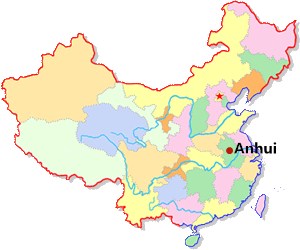Skype: neodalle-travel
Tel: +86 135 7447 2266
E-mail: sales@zhangjiajieholiday.com

Anhui Province is an inland province in Southeast China. It stretches over the Yangtze River and Huai River, and is adjacent to six provinces of  Jiangsu, Zhejiang, Jiangxi, Hubei, Henan and Shandong.The total area of the Province is over 140,100 square kilometres with a population of about 69 million, including the Han, Hui, She and other nationalities. Hefei is its provincial capital. Hefei City, the capital of the province, has many attractions as a result of its 2,000 years of history.
Jiangsu, Zhejiang, Jiangxi, Hubei, Henan and Shandong.The total area of the Province is over 140,100 square kilometres with a population of about 69 million, including the Han, Hui, She and other nationalities. Hefei is its provincial capital. Hefei City, the capital of the province, has many attractions as a result of its 2,000 years of history.
Anhui Facts
Chinese Name: 安徽 (án huì)
Location: in north-western part of eastern China
Capital: Hefei
Area:140,`00 square km
Population: 7.0829 million (2018)
Nationalities: Han,Hui,She
Administratives: By the end of 2017, Anhui Province had jurisdiction over 16 provincial cities, 7 county-level cities, 54 counties, and 44 municipal districts.
History of Anhui
During the Spring and Autumn Period (770-1476 BC), Wu and Chu Kingdom were established in today’s Anhui Province. As early as the Three Kingdom, Tang and Song Dynasties, agriculture and handicraft industries in Anhui area already occupied an important position in the national economy. But in the old China, the beautiful and richly endowed Anhui Province was afflicted with all ills and reduced to ruins because of the corrupt and decadent rule of the successive reactionary ruling classes in history. Now great changes have taken place in both the urban and rural areas. Anhui culture has a long history and consists of four cultural circles: Huizhou culture, Huaihe culture, Minjiang culture and Zhangzhou culture.
Geography of Anhui
Anhui is located in the eastern part of China. It is an integral part of the most dynamic Yangtze River Delta. Characterized by the Yangtze River and the Huaihe River flowing through it,the province has an easy access to the ocean.
The terrain consists of plains, hills and mountains; the land spans the three major river systems of the Huaihe River, the Yangtze River and the Qiantang River. Anhui Province is located in the warm temperate zone and subtropical transition zone. The north of the Huaihe River is a warm temperate semi-humid monsoon climate, and the south of the Huaihe River is a subtropical humid monsoon climate.
Anhui Province is a minority-split province with 55 ethnic minorities. The Hui, Manchu and She ethnic groups are ethnic minorities in Anhui province. The existing minority population is about 500,000 which are live mainly in Huaibei City.
Population & Nationality
By the end of 2018, the total number of permanent residents in Anhui was 70.0829 million.
Anhui is a province where ethnic minorities scatter. According to the Sixth National Census conducted in 2010, there are 395.6 thousand permanent residents of 55 ethnic minorities living in Anhui, accounting for 0.66 percent of the total population of the province. The Hui, Manchu and She have lived in the province for generations, among which, the Hui has the largest population. There are 11 ethnic townships (farm or street), 135 ethnic villages and 122 ethnic primary or secondary schools.
The Hui is the ethnic minority with the largest population widely distributed in Anhui. The Hui people's settlement in the province can date back to the Tang and Song Dynasties. Its population grows as more immigrate. Today, most of them dwell in the north of the Huai River.
Natural Resource
The good environment, particularly the mild weather, plentiful precipitation and loamy soil, make Anhui an ideal habitat for many sorts of animals and plants. The Chinese alligator and Chinese river dolphin are rare animals in the world that live in the Yangtze River flowing through the middle of Anhui.
Anhui produces a wide range of agricultural products. Its output of grain, cotton and oil ranks Anhui ahead of other provinces in the nation.
Anhui is rich in mineral resources. Its deposits of metal minerals and metalloid minerals are both diverse and abundant. The variety and abundance of the minerals rank Anhui ahead of other provinces in the country. About 128 different kinds of minerals have been discovered.
Anhui Province boasts of abundant tourism resources, and is a top tourist attraction among many in the Southeast, such as: the amazing Mount Huangshan, famous for its towering pines, precipitous stones, wonderland cloud-sea and hot springs;Mount Jiuhua, one of the four famous Buddhist Mountains in China; Mount Tianzhu, also a well-known scenic spot. The magnificence of these peaks is simply stupendous. Standing on top of any one of these peaks would overwhelm most trekkers with a sight to behold.
In addition to the beautiful mountain scenery, the well-preserved ancient villages in the southern part are derived from the Ming and Qing Dynasties (1368 - 1911). The most impressive ones are in Xidi and Hongcun Ancient Villages in Yixian County near Mount Huangshan. It is really a sight worth seeing and a must for visitors who are keen to learn more about life during those years. Shexian County, reputed as Town of Arches, is also a must for each visitor who wants to experience fine examples of residential architecture from the Ming and Qing Dynasties and the unique Tangyue Memorial Archway.
With Yellow Mountain, Anhui is a beautiful province, Welcome to China, let's meet in Anhui!
 Ask Questions ?
Ask Questions ?